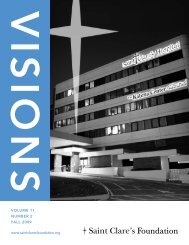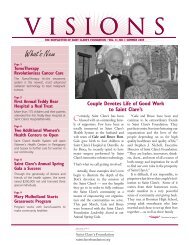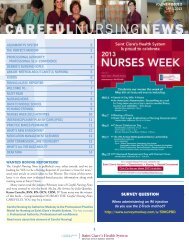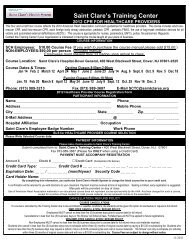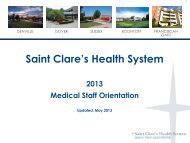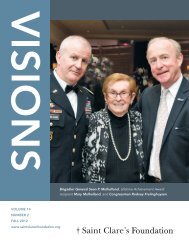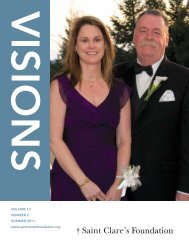July - Saint Clare's Hospital
July - Saint Clare's Hospital
July - Saint Clare's Hospital
Create successful ePaper yourself
Turn your PDF publications into a flip-book with our unique Google optimized e-Paper software.
VOLUME 3 ISSUE 4<br />
NDNQI<br />
This October, <strong>Saint</strong><br />
Clare’s Health System<br />
will again participate in<br />
the National Database<br />
of Nursing Quality Indicators<br />
RN Survey. The survey is offered to direct care RNs in member<br />
hospitals. According to the NDNQI, in 2011 over 325,000 RNs<br />
from 893 hospitals responded to the survey. The purpose of the survey<br />
is to obtain a picture of the RN work climate on every participating<br />
unit in <strong>Saint</strong> Clare’s. This year, the Maternal Child units will<br />
participate for the first time and <strong>Saint</strong> Clare’s will utilize the long form.<br />
Confidentiality is protected and reported information is summarized<br />
for the entire hospital as a whole and individual units. Details will<br />
emerge as the October start date gets closer.<br />
Marianne DeAlessi, BSN, MPA, RN, CSN-NJ<br />
Director of Nursing, RRC<br />
UNDERSTANDING BULLYING IN THE<br />
WORKPLACE: PART 2, THE EFFECT ON<br />
THE NURSING TEAM<br />
In Part 1, what is bullying? a definition of bullying/workplace violence<br />
and five types of bullying were discussed. To review, bullying is<br />
consistent, repeated, offensive behavior that undermines employees<br />
and creates a stressful work environment for the victim and the other<br />
employees (Beers, 2012). Bullying can be both covert, subtle rude behaviors<br />
and innuendos, or overt, openly abusive, physical or psychological<br />
(Lesley, 2006). The five categories of bullying include: 1) threat<br />
to professional status, 2) threat to personal standing, 3) isolation, 4)<br />
overwork, and 5) destabilization (Rayner & Hoel, 1997). The challenge<br />
to the reader at the end of Part 1 was to observe the personal<br />
work environment to identify any bullying behaviors that may fit into<br />
one of the five categories. Nurses often tolerate bullying as part of the<br />
job and unless nurse leaders provide training, nursing staff may not<br />
identify the behaviors toward them as bullying. Identification of bullying<br />
is necessary to prevent deterioration of the nursing team, which<br />
promotes a safe patient care environment.<br />
The effects of bullying on the nursing team result in decreased<br />
motivation, decreased morale, decreased productivity, increased error<br />
rates, increased turnover, and increased stress (Martin, Gray & Adam,<br />
2008; Yildirum, 2009). Verbal abuse is the most common but least addressed<br />
behavior on the nursing unit. The verbal abuse behaviors of<br />
- 10 -<br />
the bully include aggressive communication behavior, sarcasm, insults,<br />
and refusal to support the nursing team. On nursing units, the staff<br />
sometimes creates work-a-rounds to reduce interaction with a bully.<br />
An example of subordinate to manager vertical workplace violence<br />
is when a unit secretary is rude or sarcastic toward the charge<br />
nurse. The nurse may ask the unit secretary to place a call to a physician<br />
and the unit secretary responds with undertones, nasty facial expressions,<br />
or does not make the call. The charge nurse is intimidated<br />
and may create a work-a-round such as asking a nursing assistant to<br />
perform the task, or doing the task herself so that she does not have<br />
to interact with the bully. All of the nursing team members, including<br />
the manager, are probably aware of the situation and bullying behaviors,<br />
but no action is taken to address the behavior. The result is a<br />
devalued feeling among the rest of the nursing team. One concern is<br />
that if an emergency occurs on the nursing unit, and the unit secretary<br />
is scheduled to leave the unit for a break, the deflated charge nurse<br />
may not confront the bully and ask her to take her break at a later<br />
time. The message the nurse leader is sending to the staff is that the<br />
bullying behavior is acceptable, which further demoralizes the staff<br />
and creates a stressful environment.<br />
Verbal abuse by power and status occurs between a physician and<br />
a nurse or a patient and a nurse. The literature documents several studies<br />
where nurses fall prey to the verbal abuse of physicians. Physicians<br />
may scold, demean, or behave in an intimidating manner to nurses in<br />
public areas and in front of patients. Physician intimidation may result<br />
in delays in patient care because nurses may become afraid to call<br />
with abnormal blood values or change in status. A novice nurse may<br />
be intimidated to the point that she is unable to critically think in an<br />
emergent situation in the presence of a physician who is intimidating<br />
(Berry, Gillespie, Gates, & Schafer, 2011). Patients may be verbally<br />
and at times, physically abusive to nursing team members citing the<br />
Patient Bill of Rights as a license to be abusive.<br />
The patient is a passive victim of bullying behaviors for several<br />
reasons. Morale is low on the unit which results is decreased team<br />
work that causes delays to patient call bell requests and may result in<br />
care delays if a nurse or nursing assistant is tied up with a patient and<br />
can’t attend to other patients or round hourly. A positive correlation<br />
between nursing staff illness and bullying results in increased sick calls<br />
and turnover rates, which in turn may result in short staffing and increased<br />
agency nurse usage (Berry, Gillespie, Gates, & Schafer, 2011).<br />
Bullying behaviors of seasoned nursing staff impedes the ability of the<br />
novice nurse to focus on critical thinking skills, and cope in complex<br />
situations. The delay in gaining competency skills results in decreased<br />
(continued)




